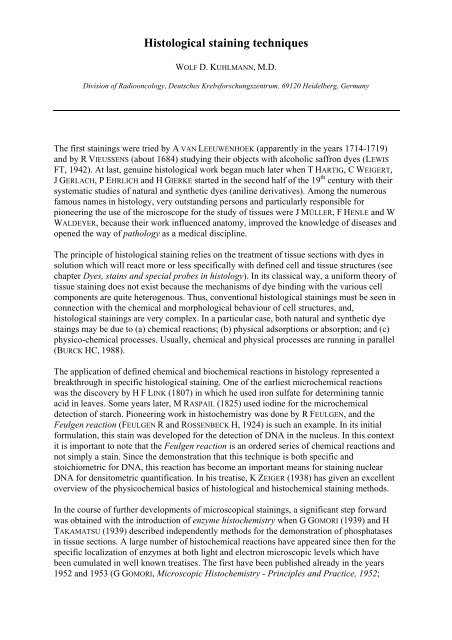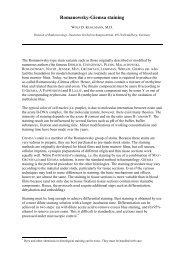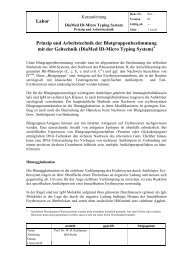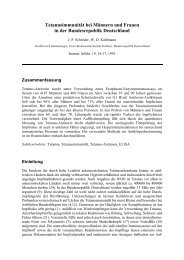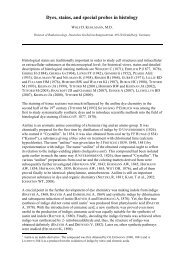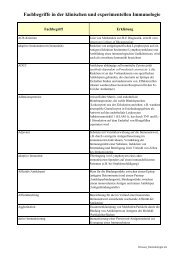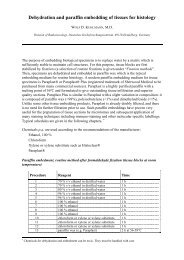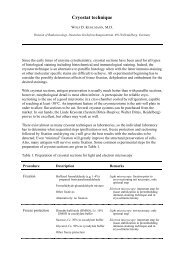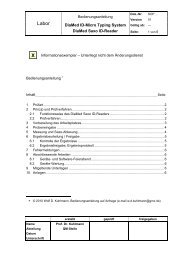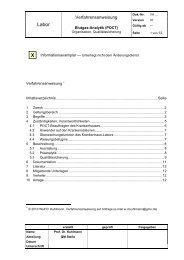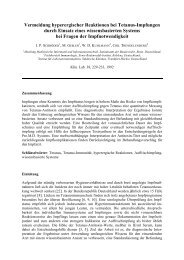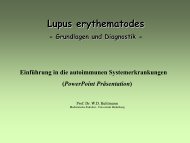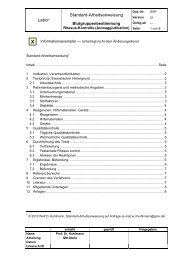Histological staining techniques
Histological staining techniques
Histological staining techniques
- No tags were found...
You also want an ePaper? Increase the reach of your titles
YUMPU automatically turns print PDFs into web optimized ePapers that Google loves.
<strong>Histological</strong> <strong>staining</strong> <strong>techniques</strong>WOLF D. KUHLMANN, M.D.Division of Radiooncology, Deutsches Krebsforschungszentrum, 69120 Heidelberg, GermanyThe first <strong>staining</strong>s were tried by A VAN LEEUWENHOEK (apparently in the years 1714-1719)and by R VIEUSSENS (about 1684) studying their objects with alcoholic saffron dyes (LEWISFT, 1942). At last, genuine histological work began much later when T HARTIG, C WEIGERT,J GERLACH, P EHRLICH and H GIERKE started in the second half of the 19 th century with theirsystematic studies of natural and synthetic dyes (aniline derivatives). Among the numerousfamous names in histology, very outstanding persons and particularly responsible forpioneering the use of the microscope for the study of tissues were J MÜLLER, F HENLE and WWALDEYER, because their work influenced anatomy, improved the knowledge of diseases andopened the way of pathology as a medical discipline.The principle of histological <strong>staining</strong> relies on the treatment of tissue sections with dyes insolution which will react more or less specifically with defined cell and tissue structures (seechapter Dyes, stains and special probes in histology). In its classical way, a uniform theory oftissue <strong>staining</strong> does not exist because the mechanisms of dye binding with the various cellcomponents are quite heterogenous. Thus, conventional histological <strong>staining</strong>s must be seen inconnection with the chemical and morphological behaviour of cell structures, and,histological <strong>staining</strong>s are very complex. In a particular case, both natural and synthetic dyestaings may be due to (a) chemical reactions; (b) physical adsorptions or absorption; and (c)physico-chemical processes. Usually, chemical and physical processes are running in parallel(BURCK HC, 1988).The application of defined chemical and biochemical reactions in histology represented abreakthrough in specific histological <strong>staining</strong>. One of the earliest microchemical reactionswas the discovery by H F LINK (1807) in which he used iron sulfate for determining tannicacid in leaves. Some years later, M RASPAIL (1825) used iodine for the microchemicaldetection of starch. Pioneering work in histochemistry was done by R FEULGEN, and theFeulgen reaction (FEULGEN R and ROSSENBECK H, 1924) is such an example. In its initialformulation, this stain was developed for the detection of DNA in the nucleus. In this contextit is important to note that the Feulgen reaction is an ordered series of chemical reactions andnot simply a stain. Since the demonstration that this technique is both specific andstoichiometric for DNA, this reaction has become an important means for <strong>staining</strong> nuclearDNA for densitometric quantification. In his treatise, K ZEIGER (1938) has given an excellentoverview of the physicochemical basics of histological and histochemical <strong>staining</strong> methods.In the course of further developments of microscopical <strong>staining</strong>s, a significant step forwardwas obtained with the introduction of enzyme histochemistry when G GOMORI (1939) and HTAKAMATSU (1939) described independently methods for the demonstration of phosphatasesin tissue sections. A large number of histochemical reactions have appeared since then for thespecific localization of enzymes at both light and electron microscopic levels which havebeen cumulated in well known treatises. The first have been published already in the years1952 and 1953 (G GOMORI, Microscopic Histochemistry - Principles and Practice, 1952;
AGE PEARSE, Histochemistry Theoretical and Applied, 1968, 1980). All these developmentsproved useful in the analysis of organ systems and cell compounds.In the meantime, however, enzyme histochemistry in its strict sense has become a limitedrole. With the use of antibody labelings, originally introduced by AH COONS in 1941 asimmunofluorescent technique, immunohistological methods are now regarded as tools withgreater potential.Immunohistology for specific cell analysisImmunohistology was invented for the histologist as a specific histological tool for theidentification of biomarkers which are relevant for the understanding of structure-functionrelationshipsin cells and organs. Biomarkers are molecules with particular features that makethem useful for histological tracing, measuring and monitoring under certain conditions suchas phylogenetic, ontogenetic and disease development.Methods which use antibodies are of special importance due to the inherent specificity of theantigen antibody reaction. Since their discovery by E VON BEHRING and S KITASATO (1890)more than a century ago, antibodies are used as highly selective ligand binding proteins andare widely employed for the detection and separation of antigenic molecules.Immunohistology will give complementary diagnostic information to that obtained by thetraditional morphological observations. The concept of cellular antigen <strong>staining</strong> in tissuesections by labeled antibodies dates back to the early work of A H COONS and co-workers in1941 describing an immunofluorescence technique for the microscope. In the beginning,simple methods were used which lacked sensitivity and specificity. Since then, improvementshave been made in conjugation <strong>techniques</strong>, tissue fixation, selection of labels andmicroscopes.Now, immunohistochemistry has become part of molecular tissue pathology.The technique is a powerful but very complex tool, especially the use of high sensitiveprocedures and their application to detect one or multiple antigens in the same cell or tissuepreparation.Antibodies have applications in research, in diagnostics and in many specialized purposeswhich include pathology, forensic medicine, biochemistry and biology. Together with themodern concepts of molecular biology (notably nucleic acid probing by specific interaction ofnucleic acid sequences with complementary probes and the polymerase chain reaction),antibody <strong>techniques</strong> are part of the most important tools in the study of the molecular andstructural composition of cells. The extraordinary potential of immunocytochemistry canbridge molecular, cellular, organismal, and clinical investigations. Embedded in currentproteomic technologies including cancer proteomics, immunocytochemistry contributes to theidentification and understanding of complex changes in protein profiles.Ligand-binding molecules for selective cell labelingAntibodies possess a high degree of specificity towards antigenic determinants. Because ofthe narrow range of specificity of an antibody molecule to bind with its antigenic determinant,immunochemical methods are very sensitive <strong>techniques</strong>. With respect to the definition ofantigenic molecules (substances which initiate the formation of and react with antibodies are
called antigens), immunological methods are widely employed in qualitative and quantitativeapproaches since the very early years of the last century e.g. by EHRLICH, LANDSTEINER,WITEBSKY, HEIDELBERGER, MARRACK, KABAT, OUDIN, GRABAR and schools derived fromthese pioneers in immunochemistry.Several types of antibody preparations exist for immunocytochemistry. These includeantibodies of polyclonal or monoclonal origin; a pool of monoclonal antibodies is also useful.Polyclonal antibodies are readily obtained from animals (e.g. rabbit, goat, sheep, mouse orrat) upon immunization with appropriate antigen. Also, autoantibodies from patients withcertain diseases may be used. These immune sera, however, will contain a mixture ofnumerous antibody populations directed against the different epitopes of the immunizingantigen. Hence, hyperimmune sera will suffer from the drawback of limited reproducibility.In order to overcome this problem, monoclonal antibodies will be a good alternative; they canbe obtained by hybridoma <strong>techniques</strong>. Their great reproducibility and inherent antigenspecificity for defined antigenic epitopes make monoclonal antibodies useful tools inimmunological <strong>techniques</strong>.Furthermore, genetic engineering such as phage display enables the production ofrecombinant antibodies. Usually, the sophisticated protein folding and modificationmachinery of mammalian cells is needed to obtain biologically active antibodies. Some ofthese limitations can be overcome by using smaller antigen-binding fragments of antibodieslike Fab fragments which can be produced in E. coli. Then, alternative protein architectureswhich are easier to handle may become attractive. A novel class of engineered ligand-bindingproteins such as the anticalins provide suitable properties as laboratory and diagnostic tools.A number of phenomena which resemble antibody reaction are shared by lectins. These occurin a variety of plants, invertebrates and vertebrates and are used for the study of carbohydratemoieties. With their ubiquitous role in virtually all biological systems, glycans are vitallyimportant molecules. Glycans are a large group of compounds consisting of sugars withdiverse structures that are present inside and on the surface of cells. More than 50% of allproteins carry various glycan chains. They fulfill many different roles by interacting withproteins in a variety of biological events which underlie the development and function inmulticellular organisms. Because lectins possess a high affinity and a narrow range ofspecificity for defined sugar residues, they are a powerful tool in carbohydrate studies.Lectins are today the most specific molecular probes for the histological localisation ofglycoconjugate glycosylation. The principles described for immunohistology hold also truefor lectin histology. In a similar way to immunohistological <strong>techniques</strong>, lectins which areeither conjugated with markers such as fluorescein, enzymes etc. or not can be employed in“direct” and “indirect” <strong>staining</strong> procedures. In the latter <strong>techniques</strong>, a defined labeledantibody system is needed to localize the reaction site of the lectin itself.In situ <strong>staining</strong> of molecules in cells and tissue preparationsWith respect to immunocytochemistry, the purpose of most described procedures is theidentification and characterization of cellular structure and function in situ rather thanimmuno-<strong>staining</strong> of physicochemically isolated constituents. Because the principles ofimmunohistology hold also true for nucleic acid <strong>staining</strong> by DNA and RNA hybridization<strong>techniques</strong>, both <strong>techniques</strong> are candidates to be joined in the study of life processes whichdepend so much on multiple external and intrinsic conditions. Usually, only parts of thegenome become expressed as RNAs which concentrations, however, are not strongly
correlated with the expression of proteins. Thus, studies of gene expression together withanalysis of the proteome can provide useful information about the presence of characteristicproteins in defined conditions.To this aim, the respective ligands are usually “labeled” in a way so that the formedcomplexes become “visible”. Suitable substances for labeling purposes are those which leadto distinct fluorescent or colored reactions (light microscopic level) or which give significantdeflection of electrons at the electron microscopic level. A milestone for investigations at theelectron microscopic levels was the conjugation of the metalloprotein ferritin with antibodiesby S J SINGER (1959) which enabled a new era of ultrastructure research.As mentioned above, immunohistological <strong>techniques</strong> date back to the early works of A HCOONS and co-workers in the early forties of the 20 th century. Their immunofluorescentapproach opened specific investigations on cellular structure and function at the lightmicroscopic levels. Apart from the popular fluorophore labelings, enzymes are veryinteresting alternatives as marker molecules because they can be utilized for both light andelectron microscopic studies. The first successful enzyme conjugation procedure for cellularantigen <strong>staining</strong> was developped by P K NAKANE and G B PIERCE (1966).Immunocytochemical developments are still in progress with respect to both antibodylabeling methods and microscopes including image analysers and cameras which make cell<strong>staining</strong> more sensitive. It can be expected that these <strong>techniques</strong> will become morequantitative.When labeled antibodies are used, cell <strong>staining</strong> can demonstrate the presence and thesubcellular localization of an antigen. Furthermore, double or multiple labeling methods allowthe simultaneous detection of different antigens. Immunohistological methods can be alsoused in conjunction with many conventional histological stains and with autoradiography inorder to compare the localization of the antigen with other cell-type markers. Moreover,immuno-<strong>staining</strong> <strong>techniques</strong> can be performed in connection with other selective <strong>staining</strong>procedures as for example in the research of glycans by the use of lectins or in nucleic acidlabeling by use of selective nucleic acid probes.The use of nucleic acid probes for the detection of DNA/RNA at the cellular levels follows<strong>staining</strong> principles which are quite similar to immunohistology. As described above,similarities concern the choice of marker molecules as well as the <strong>staining</strong> protocols (directand indirect <strong>staining</strong>s) coupled with various antibody based detection systems. Popularnucleic acid <strong>staining</strong>s include the detection of genomic aberrations by single chromosomespecific probes (FISH, fluorescence in situ hybridization), genetic mutations and geneexpressions as well as studies on foreign genetic material as in the case of infectious agentsby specific nucleotide probes with the <strong>techniques</strong> of in situ hybridization and in situ PCR.Technical developments are certainly just at the beginning.In any case, generalized standard procedures for the detection of cellular ligands are notavailable. Usually, immuno-<strong>staining</strong>s must be established to each cellular model, f.e. byadaptation from existing protocols. Staining schedules have to reconcile at least three mainsteps: Specific antibody production or selective choice of another ligand specificity (f.e.artificial receptor proteins, lectins etc.) or appropriate nucleic acid sequences whenprobing for chromosomes and genomic DNA/RNA by in situ hybridization/in situ PCR,Selection of a detection system suitable for histological studies,Cell and tissue preparation including an appropriate fixation procedure.
Even if a wide range of ready-to-use reagents can be purchased, now, one has always toconsider two aspects in immunohistology: (a) type and characteristics of the necessaryreagents, and (b) type and morphological features of the cells/tissues to be stained. It appearsnecessary to work out primary and secondary antibodies and the best labeling conditions.Then, different tissue sampling protocols including different fixation schedules must bestudied. For immunohistological <strong>staining</strong>s, different antibody concentrations, differentincubation times and temperatures as well as different methods of blocking non-specific celllabeling must be examined. Because of all the numerous technical details in the preparation ofantibodies, the selection of markers and their conjugation with antibodies, the preparation oftissues and the performance of cellular <strong>staining</strong>s, these aspects will be described in separatesections.Evaluation of stained tissue sectionsImmunostained sections with or without contrast enhancement (e.g. by postfixation withOsO 4 ) and either counterstained (e.g. with hematoxylin) or not are observed in the lightmicroscope with typical Köhler’s bright field illumination; for fluorescent preparations seechapter Fluorescence and fluorescence microscopy. Photographs are taken with an automaticmicroscope camera equipped with an electronic switch unit. Photos can be recorded on 35mm black and white negative film (e.g. 18 DIN/50 ASA), on 35 mm tungsten color reversalfilm (e.g. 18 DIN/50 ASA; 3200º K) or on daylight color reversal film (e.g. 18 DIN/50 ASA).In the latter case, the lamp temperature is corrected from 3100º K to 5500º K by a conversionfilter. The exposure time is modulated by gray filter. Alternatively, viewed tissue sections arerecorded by an integrated CCD color video camera. Documentation and archiving is done ondisk by appropriate software.In the case of immuno-electron microscopy, ultrathin sections are viewed by conventionaltransmission electron microscopesoperating at 80 kV with bright field illumination. Forcontrast enhancement, sections may be counterstained with lead citrate (e.g. for 30 sec) orother means. Areas of interst are either photographed with commercial film material (e.g. 6.5x 9 cm) or recorded by electronic video camera. The viewed areas are documented andarchived on disk by appropriate software.Electronic documentation is today state-of-the-art in light, fluorescent and electronmicroscopies which allow to take measures in signal gain, contrast enhancement, noiseelimination etc. Especially in modern fluorescence microcopy, imaging and high resolution offluorescent signals depend largely on sophisticated electronic means.Selected publications for further readingsLeeuwenhoek A van (1673)Link HF (1807)Raspail M (1825)Müller J (1838)Gerlach J (1848)Hartig T (1854a, 1854b)Gerlach J (1858)
Henle F (1840)Henle F (1855)Waldeyer W (1863)Weigert C (1871)Ehrlich P (1877)Ehrlich P (1878)Weigert C (1878)Gierke H (1884)Ehrlich P (1886a, 1886b, 1886c, 1886d)Behring E von and Kitasato S (1890)Weigert C (1904)Feulgen R and Rossenbeck H (1924)Zeiger K (1938)Gomori G (1939)Takamatsu H (1939)Coons AH et al. (1941)Lewis FT (1942)Gomori G (1952)Coons AH (1954)Weller TH and Coons AH (1954)Coons AH et al. (1955)Coons AH (1958)Riggs JL et al. (1958)Singer SJ (1959)Beutner EH (1961)Nakane PK and Pierce GB (1966)Avrameas S and Lespinats G (1967)Pearse AGE (1968)Avrameas (1970)Nairn RC (1976)Kuhlmann WD (1977)Sternberger LA (1979)Pearse AGE (1980)Kuhlmann WD (1984)Burck HC (1988)Masters BR (2006)Full version of citations in chapter References.© Prof. Dr. Wolf D. Kuhlmann, Heidelberg 11.11.2008


